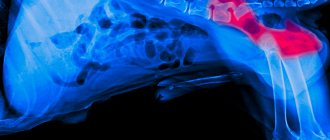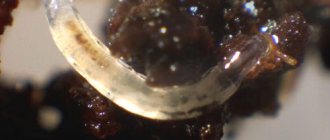Epilepsy in dogs is a common, chronic neurological disorder that causes the animal to experience sudden, uncontrollable, repeated seizures. Epileptic seizures (fits) can occur with or without loss of consciousness. The first seizure can frighten an owner who has never seen seizures in dogs. Don't be afraid - this is not a death sentence! But there is no need to relax - the disease must be diagnosed and treated in time. From our material you will learn why there is no need to be afraid of seizures, what the owner should know about epilepsy. Learn how to stop seizures and help your pet. This knowledge will help you react correctly to your pet’s condition and provide your dog with competent assistance in a timely manner.
First aid
The most important thing an owner can do for his dog is to remain calm and sober. This is the first and main point in our memo. During an attack, a dog has absolutely no control over itself and its behavior; it can injure itself. The owner must be nearby to protect the pet from possible bruises and injuries.
Reminder - what to do during a seizure
- The most important thing is to remain calm and not touch your pet during a seizure. Some owners try to move the animal, they want to put it in a safe place. This is mistake! When the seizure begins, leave the dog in the place where the seizure occurred .
- The only case when you can shift the dog is if the seizure overtook him on a high staircase. The risk of falling must be eliminated.
- Move furniture and other furnishings that your pet could hit. Your task is to ensure that the dog does not injure itself.
- Create silence and darkness in the room where the sick animal is located. There is no need for the whole family to crowd around the pet.
- Provide fresh air into the room. Open the vents, windows, doors.
- There is no need to try to calm your pet with words and gestures - this can provoke an increase in neurotic reaction.
- Do not touch or hold the dog . The only thing you can do is gently turn her head to the side.
- Do not try to open your jaw with your hands or objects . An animal may bite you. To prevent the tongue from sticking, the animal must be on a flat floor with its head turned to one side.
- To help your veterinarian make a diagnosis, time the start and end of the seizure. It will be very good if you manage to film the attack on video and keep a special diary for recording seizures.
- When the seizures end, contact your veterinarian, tell him about the symptoms, duration of the seizures. If the seizure lasted for a long time (more than 5 minutes), invite a doctor to your home.
Important!
Forget the common advice of inserting a spoon between the animal's teeth to open the jaws. This is a wrong recommendation. This can injure the dog.
Classification of epilepsy
Epilepsy in dogs is divided into structural (acquired) and idiopathic (congenital).
Structural (secondary) epilepsy
The root cause of this type of epilepsy is some kind of brain pathology. Seizures occur against the background of abnormalities in brain development, injuries, infectious pathologies, and neoplasms in the brain.
Idiopathic epilepsy
This is the most common type of epilepsy in dogs. This diagnosis is made if the underlying cause of the seizures cannot be identified. The disease usually affects young animals from six months to 6 years.
It is generally accepted that idiopathic epilepsy occurs as a result of a combination of genetic predisposition and negative external factors. The disease is lifelong; the dog requires lifelong observation and supportive therapy.
Can a dog die
Death from epilepsy occurs if an attack is accompanied by spontaneous cessation of breathing (asphyxia). During convulsions, the pet loses orientation in space, which leads to severe bruises and damage. In some cases, these injuries are not compatible with life. If the dog is not treated, the disease progresses. Seizures recur more often, are more severe, and last longer. For the body, this is severe stress, depleting the nervous and immune systems. After each subsequent attack, the animal weakens and may eventually die, unable to withstand the load.
Causes
Epileptic seizures occur for a number of reasons. Some of them are hereditary, some are acquired.
Congenital causes
- Degenerative pathologies of the brain.
- Head injuries received at birth.
- Infectious diseases during a dog's pregnancy can cause epilepsy in puppies.
- Unfair breeding of purebred animals with defective genes and closely related individuals.
All congenital causes can only be identified after in-depth diagnostic studies.
Acquired reasons
- Traumatic brain injuries sustained in childhood and adulthood.
- Neoplasms of benign and malignant nature in the brain.
- Viral and bacterial infections.
- Toxic effects of lead, mercury, arsenic and other toxic substances.
- Hormonal imbalance due to endocrine pathologies.
- Exhaustion due to prolonged fasting or poor diet.
- Severe fear, stressful situations.
- Serious pathologies of internal organs and systems: urolithiasis, heart failure, kidney and liver pathologies.
- Infection with helminths.
- Poisonous snake bites.
- Electric shock.
- Deficiency of vitamins and minerals necessary for the functioning of the nervous system: magnesium, calcium, B vitamins, vitamin D.
Important!
The causes of acquired epilepsy are often identified too late. Since several years may pass between an attack of epilepsy and the cause that caused it.
Dog Breeds Prone to Epilepsy
Idiopathic epilepsy is a genetic disorder in some dog breeds. Dogs of these breeds should be tested for epilepsy and not allowed to breed if pathology is detected.
Breeds in which epilepsy is most often detected:
- beagle;
- Golden retriever;
- Labrador Retriever;
- Belgian Shepherd Tervuren;
- dachshund;
- collie;
- Sheltie;
- Irish Setter;
- Bernese Mountain Dog;
- Finnish Spitz;
- Irish Wolfhound;
- Hungarian Vizsla;
- Keeshond;
- miniature schnauzer;
- English Springer Spaniel.
Disease - keratitis
Due to the anatomical feature of the eyes (slight bulge), the Toy Terrier often suffers from keratitis. This happens due to mechanical trauma to the cornea. The most common cause is a pricking of the eye on a blade of grass or a thin twig on a summer walk; if the wound becomes infected, an additional infection may occur. The disease is accompanied by pain in the eye and lacrimation. That terrier squints all the time, eats poorly, trembles, and is in a depressed state. If treatment for a toy terrier is not started in a timely manner, the infection can spread to the deeper layers of the eye and lead to clouding of the cornea (cataronia) and loss of vision. In each specific case, the veterinarian ophthalmologist prescribes individual treatment. Toy terrier owners often self-medicate eye diseases. Antiviral and antifungal drops are instilled into the dog's eyes one by one, everything that neighbors and friends recommended. Eye medications can only be prescribed based on the analysis. Don't waste time and don't let your dog lose his sight.
Treatment
Idiopathic (true) epilepsy cannot be treated. Only the root cause that caused the pathology can be cured.
Therapy in the case of epilepsy consists of anticonvulsant treatment, which is aimed at stopping seizures, reducing their frequency, and achieving long-term remission. The task of the owner and veterinarian is to improve the quality of life of a sick animal. With timely administration of antiepileptic drugs, long-term remission is achieved in 15-30% of dogs.
Dogs with idiopathic epilepsy who experience 1 to 2 seizures per year are not prescribed treatment.
When does a dog need medication?
Drug treatment is prescribed by a veterinarian based on diagnostic studies and analysis of the nature of the attacks based on the diary kept by the owner.
Therapy is prescribed in the following cases:
- the animal has more than 1 seizure per month;
- the duration of each attack is more than 5 minutes;
- convulsive seizures are repeated one after another after a short period of time;
- the severity of the seizures increases, the dog’s condition worsens.
Such animals are prescribed lifelong treatment under constant veterinary supervision. To select the correct dosage and monitor the pet’s condition, the doctor must check the pet’s health and do a blood test.
Important!
Do not neglect regular preventive examinations in order to promptly identify possible negative consequences of antiepileptic therapy or epilepsy attacks.
Medications
The list of veterinary drugs used in the treatment of epilepsy is insignificant - this is due to their high toxicity.
Domestic and foreign veterinarians use the following medications in antiepileptic therapy for dogs:
Phenobarbital
An effective anticonvulsant and sedative that has been used for a long time. Reduces the dog's excitability, increases resistance to stressful situations, and prevents epileptic seizures. Available in the form of injections, tablets and syrup. The medicine is dispensed from the pharmacy with a prescription. Strict adherence to the dosage prescribed by the veterinarian is required.
Recommended starting dose: 2.5-3 mg/kg 2 times a day.
Contraindications : chronic liver diseases.
Side effects:
- sedation (drowsiness);
- polyphagia (gluttony);
- partial or complete loss of coordination of movements (ataxia);
- thirst and increased urination.
Imepitoin
The new generation drug has been used in veterinary practice since 2013. Recommended for identifying idiopathic epilepsy. Has fewer side effects. Available in tablets.
Recommended initial dose: 10-20 mg/kg 2 times a day.
Contraindications : weight below 5 kg.
Side effect : gluttony (polyphagia).
Potassium bromide (KBr)
It is used in veterinary medicine only as an adjuvant in complex therapy with anticonvulsants. Improves control of seizures. It has many side effects and must be taken under constant veterinary supervision.
Recommended dosage: 15 mg/kg 2 times a day.
Contraindications : kidney and liver pathologies.
Side effects:
- drowsiness;
- voracity;
- loss of coordination of movements;
- hind limb weakness;
- vomiting and nausea.
The first two drugs are first-line drugs. The veterinarian may prescribe your dog either Phenobarbital or Impetion, a new generation anticonvulsant drug.
Potassium bromide is prescribed additionally if therapy with first-line drugs does not produce the desired effect. Combination use of drugs is possible. The type of drugs and their combination, as well as the dosage, is chosen by the attending veterinarian. Self-medication is unacceptable for this serious pathology.
Important!
Never give dogs epilepsy medications from a human medicine cabinet.
Diet for epilepsy
Proper diet plays an important role in the prevention and treatment of dogs with epilepsy . Your veterinarian may be able to create a new diet for your sick dog to help control seizures.
- The main rule is to be consistent. Frequent changes in food can trigger attacks.
- Follow feeding standards - do not overfeed, and do not keep your pet on a starvation diet.
- Give meals at the same time, stick to the schedule.
- Do not give your dog hot or cold food - only warm food is allowed.
- Include in the diet of dogs on a natural diet: sardines, legumes, white cabbage, boiled carrots and millet. The amount of animal proteins needs to be reduced. Avoid salty foods.
- Ready-made feeds should contain sufficient amounts of magnesium, B vitamins and manganese.
- Naturally fed pets must be given vitamin and mineral complexes as prescribed by a veterinarian.
Alternative Treatments
Traditional medicine is not used for epilepsy. Only vitamin therapy and acupuncture are allowed for dogs. Acupuncture is carried out on 10 sensitive points, in sessions of 20 minutes. within 30 days. Vitamin therapy is aimed mainly at replenishing the deficiency of B vitamins.
Important!
These methods do not replace traditional medicine; they are prescribed as part of complex therapy along with anticonvulsants.
Disease - gastritis
This terrier has a poor appetite, which greatly worries its owners. It is difficult to accustom him to a diet. Food in a bowl can sit all day. The owner begins to try to feed the dog anything, and he, in turn, waits for something tasty to be given, sausage, sausages, cheese, etc. are used. That terrier, trembling and blinking his eyelashes, slowly and reluctantly eats what was offered. This behavior of humans and dogs soon leads to gastritis. It can begin suddenly, accompanied by periodic vomiting, diarrhea, and pain. The toy terrier whines and arches his back. Often, after an outbreak of acute gastritis subsides, the disease becomes chronic.
In the future, the pet requires a lifelong diet. Very similar symptoms and the same reasons (malnutrition) cause gastroenterocolitis. Based on gastroscopy, your veterinarian will give your toy terrier the correct diagnosis and prescribe treatment.
What should the owner of a sick animal do?
- The tablets should be given at the same time every day.
- It is important to follow the prescribed dosage.
- It is unacceptable to interrupt or stop treatment without a veterinarian's prescription.
- Do not resort to traditional methods of treatment. They are not effective for epilepsy.
- Keep a diary in which you note all epileptic seizures and describe their duration and symptoms.
- Visit the clinic every 3 months to have blood drawn and see a neurologist.
Important!
Long-term use of antiepileptic drugs can lead to the development of anemia in the dog. Get your blood tested regularly.
Does it happen in dogs?
Diseases in humans and pets are similar in many ways. Dogs also suffer from epilepsy. The mechanism of transmission of nerve impulses in humans and animals is the same. First, the neuron is excited and then inhibited. Doctors explain an epileptic seizure as a “fire effect” when a persistent focus of excitation appears in the cerebral cortex. Continuous nerve impulses cause prolonged contraction of muscle fibers. Hence convulsions, temporary loss of hearing or vision, and uncontrolled behavior of the animal.
Read: Seizures in dogs
How to know if treatment is helping
Antiepileptic therapy is considered successful if seizures stop completely or their number is reduced by half. If a 50% reduction in the frequency of attacks cannot be achieved, the doctor may prescribe additional medications or increase the dosage of monotherapy.
How to detect epilepsy attacks
To evaluate the effectiveness of treatment, it is important to keep a diary and note all recorded cases in it. For the convenience of owners of dogs with epilepsy, an application for smartphones, RVC Pet Epilepsy Tracker, has been developed, in which seizures can be noted and described in detail.
You can also use the PetPace smart collar, which can detect seizures when your dog is home alone. The collar records all indicators (pulse, temperature, breathing rate) and can send the owner a message on a smartphone when a seizure is approaching.
How long do dogs with epilepsy live?
It all depends on what type of epilepsy and when the dog was diagnosed. With timely diagnosis and lifelong therapy, dogs can live to a ripe old age.
Life expectancy is affected by:
- the age of the dog at which the first seizures appeared;
- severity of epileptic seizures and their frequency;
- the dog’s reaction to therapy, the presence of side effects;
- type of epilepsy and cause of seizures;
- whether the animal receives or does not receive treatment.
Disease - collapse of the trachea
Quite often tracheal collapse occurs in toy terriers. The disease is associated with a malformation of the cartilaginous rings of the trachea. Typically appears at 4-6 months. Symptoms include a periodically hoarse cough that can begin with strong excitement (the joy of the owner returning home), after barking. One gets the feeling that the toy terrier is suffocating, taking frequently repeated breaths as if choking. Similar symptoms may occur when the velum palate descends. Only a veterinarian can differentiate these diseases. If the diagnosis of tracheal collapse is confirmed, it is possible to install an implant to help the terrier's trachea not lose its shape when inhaling and exhaling.
Diseases and recommendations for the German Shepherd
Norwich Terrier diseases and recommendations
Typical diseases of terriers and recommendations
Typical diseases and recommendations for Picardy Shepherds
Pyrenean Sheepdog diseases and recommendations
Symptoms
The dog owner needs to be able to diagnose an approaching seizure in order to have time to provide help to the pet. To do this, you need to know the symptoms of the pathology. An epileptic seizure occurs in several stages (phases), each stage has its own symptoms.
- Prodromal (early) . This period passes without significant symptoms. Duration: from several days to 2-3 hours. The animal may be worried and show increased anxiety.
- Aura (preliminary phase) . Lasts from 1 to 30 minutes. The dog shows anxiety, whines, trembles, and drools. There may be a slight loss of coordination. Sometimes the aura manifests itself as complete immobility of the animal.
- Seizure (ictal phase) . Direct epileptic seizure. Manifested by muscle cramps and arching of the body. The dog may fall, lose consciousness, suffer from hallucinations, and jerk its legs randomly. The head is thrown back. The body becomes partially numb. Increased salivation, chattering of teeth and chewing appear. Involuntary emptying of the bladder and bowels is possible. Lasts from a few seconds to 5 minutes.
- Postictal phase (recovery period) . The animal is lethargic, disoriented, with confused consciousness. The dog does not recognize the owner, gets scared, and may be overly restless. The period of recovery from a seizure can last from several hours to 3 days.
In each specific case the picture may be different. It is important to note all this in your observation diary.
Briefly about the main thing
- Epilepsy is a disease characterized by two or more seizures within 24 hours. The essence of epilepsy is a predisposition to seizures.
- The disease can be congenital, or it may appear after infection with infectious diseases, encephalomeningitis, or after traumatic brain injury.
- There are several types of attack that do not depend on the cause. Usually an attack manifests itself as convulsions, which also come in different types. However, sometimes the attack passes without convulsions, and the dog even stands normally on its feet, but loss of consciousness occurs - absence syndrome.
- There are several breeds predisposed to epilepsy, these include: Labrador Retriever, Golden Retriever, Irish Wolfhound, Belgian Shepherd and some others.
- To provide first aid to your dog during an attack, ensure its safety. Don't touch the dog, but make sure it doesn't get hurt. Under no circumstances try to open your jaws!
- It is impossible to completely cure epilepsy, but you can achieve long-term remission and significantly improve your pet’s quality of life.
Diagnostics
To make a correct diagnosis, it is important to carefully study the history. Your diary entries and descriptions of the attacks will help the doctor with this. A veterinary neurologist makes a diagnosis based on an assessment of the age of onset of epilepsy and the frequency and duration of seizures. In addition, the clinic conducts a number of diagnostic studies.
Diagnostic methods
- Collection and study of anamnesis.
- Primary visual examination, palpation.
- General urine analysis
- General and biochemical blood test.
- Determination of residual nitrogen in urea.
- Ultrasound of the abdominal organs.
- Radiography.
- CT scan.
- Fecal analysis for helminths.
- Measuring blood glucose levels.
- Electroencephalogram.
- Cerebrospinal fluid analysis.
- Measurement of lead and calcium concentrations in biological fluids.
- Cardiogram.
When diagnosing epilepsy and identifying genetic predisposition, special attention is paid to studying the dog’s pedigree. The final diagnosis is made only after studying and summarizing all the tests.
Prevention
An effective preventive measure for dogs with idiopathic (congenital) epilepsy is the creation of a safe living environment at home. In rooms where sick pets live, all sharp corners should be covered, there should be no clutter of furniture or high stairs. It is advisable to have someone with the dog at all times.
The second thing that owners of sick dogs should remember is that stress and anxiety can trigger a seizure. There is no need to overload the dogs with grueling walks and training, take part in exhibitions and shows with them, or take them on trips.
Recommendations for your Toy Terrier
WOLMAR WINSOME® PRO BIO BOOSTER Ca MINI - Calcium and vitamins for the toy terrier, especially for small breeds, for a puppy during the growth period.
WOLMAR WINSOME® COLLAGEN MCHC – For the proper formation and strengthening of the bones of the toy terrier, it will reduce injuries from falls and unsuccessful jumps.
WOLMAR WINSOME® PRO BIO GA-GLICAN – correct formation of the joints of the toy terrier and prevention of their injuries.
WOLMAR WINSOME® PRO BIO PRO HAIR – For coat and skin, in the off-season during shedding (makes ideal coat and skin).
WOLMAR WINSOME® ACIDOVIT – Prevention of gastritis in toy terriers due to improper feeding and stomach problems.











